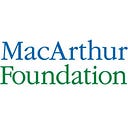Teresita Fernández: Process and Practice
We are pleased to share this article by Marin Williams, our summer art intern, who wrote about artwork in the MacArthur Foundation’s collection. This article, which comes on the final day of Hispanic Heritage Month, features the work of Cuban American artist and 2005 MacArthur Fellow, Teresita Fernandez.
Teresita Fernández’s works are often large-scale immersive environments made of shimmery materials such as silk, graphite, onyx, mirrors, and glass. So, when I first saw Teresita Fernández’s Untitled drawing from 1997 in the MacArthur Foundation’s art collection I was unsure what to make of it. While the work captured a sense of minimalism and landscape that I have come to expect of Fernández’s work, I was otherwise at a complete loss. The work depicts a sparse room filled by three large rectangles evenly spaced across the floor. The rectangles seem to be filled with a yellow/ green hue and are separated from each other by transparent archways.
As I researched this work, I discovered that the drawing was a study for an installation Fernández created in 1997 as part of a group exhibition X Site 97 for The Contemporary in Baltimore. Founded in 1989, The Contemporary is a non-collecting, nomadic museum, meaning that the museum has no permanent headquarters. Instead, the museum sponsors exhibitions and stages installations throughout the city in unlikely places for contemporary art, like abandoned buildings. X Site 97 was displayed on the ground floor of the abandoned Alex. Brown & Sons building, a former bank, amid exposed pipes, air ducts and bare cement block walls and concrete floors. This unusual environment was perfect for Fernández’s large-scale sculptures.
Landscape Projected, her final work for X Site 97, was an immersive installation set in a 20 x 30-foot room created specifically for the work. The scale of the room was intended to make visitors feel as if they were walking into an expansive landscape. To aid in this illusion, Fernández painted the entire room in a soft yellow/green hue, like that in the untitled drawing, making it difficult for visitors to distinguish between the walls, ceiling and floor creating the sense of an endless horizon. The yellow/ green rectangles in the drawing became large rectangular structures that used pipes to create a frame, with a sheer yellow/green stocking-like material stretched between the frames. The structures were intended to represent formal hedges inspired by famous French 17th- century pleasure gardens such as Versailles and Vaux le Vicomte. To further add to the illusion of being in a garden, Fernández incorporated the sound of a lawn sprinkler going around in circles.
The meaning of the work though, is still up for interpretation as Fernández prefers for viewers to draw their own conclusions of the work. In recent years, however, Fernández has been more forthcoming about her works personal and political contents.
Teresita Fernández was born and raised in Miami, Florida after her parents fled the Castro Regime in Cuba in the 1960s. Reflecting on her childhood in Miami, Fernández recalls “There was a lot of name-calling. My parents were treated really badly. I was treated badly. We didn’t belong; we were always aware of not belonging. But it was a whole city of people like that, that didn’t belong. And so there were Haitians and Bahamians and African Americans who were treated even worse than we were” (Sealy). Many of Fernández’s later works are inspired by these experiences as she grapples with the complexities of place and identity through materiality, and experiential, visual, immersive prompts.
In 2020, Fernández’s work returned to her hometown of Miami with a mid-career retrospective at the Perez Art Museum (PAM). Teresita Fernández: Elemental, as the exhibition is titled, examines work from the mid-1990s through today and provides a compressive record of Fernández’s work. In two of her more recent works included in the exhibition, Fire (America) 5 (2016) and Charred Landscape (America) (2017), Fernández reinterprets artistic traditions of depicting land, presenting a contemporary American landscape marred by violence, climate change, and warring ideologies that stands in stark contrast to the idealized vision of the American dream.
In an interview with a student from Florida International University, where Fernández received her BFA, the artist discussed the importance of having her first career retrospective held in Miami in the context of her Latinx identity:
“When I was a child, Miami didn’t have any museums… So, it is especially satisfying to come back and see the important presence that contemporary art now has here… There are almost no models for being a U.S. Latinx contemporary woman artist with visibility in the mainstream art world — one who also claims her ethnicity, without having to choose either/or. The constant need to choose between one’s artistic integrity and representing identity for others, coupled with the lack of examples of Latinx artists in American museum collections, points to larger issues of institutional racism, whitewashing and inequity in our museums and art-history narratives, or what gets to be called “American art” (Sealy).”
In addition to speaking out against these issues through her work Fernández also organized the U.S. Latinx Arts Futures Symposium. The event, first hosted in 2016, and again in 2019, by the Ford Foundation, brought together 200 artists, museum directors, scholars, curators and funders to talk about the lack of Latinx representation in the arts. Speaking to the importance of the symposium and Fernández’s leadership, Darren Walker, President of the Ford Foundation said, “Teresita is revealing the complexity of the Latinx conversation and taking a public leadership role in holding the mirror up to the art world” (Sheets).
Dorsey, John. “Women’s art is easy to get into Review: Installations at the Contemporary brings the outdoors in and the indoors out.” The Baltimore Sun. October 28, 1997. https://www.baltimoresun.com/news/bs-xpm-1997-10-23-1997296187-story,amp.html.
Sealy, Zion. “Alumna Teresita Fernández’s work on exhibit at Pérez Art Museum Miami.” FIU News. January 10, 2020. https://news.fiu.edu/2020/alumni-spotlight-teresita-fernandez-brings-new-elemental-exhibition-to-perez-art-museum-miami.
Sheets, Hilarie M. “For Teresita Fernández, Personal Is Political.” The New York Times, October 23, 2019. https://www.nytimes.com/2019/10/23/arts/design/teresita-fernandez-latinx-artists.html.
https://www.contemporary.org/about.html
https://www.lehmannmaupin.com/news/teresita-fernandez-island-universe
